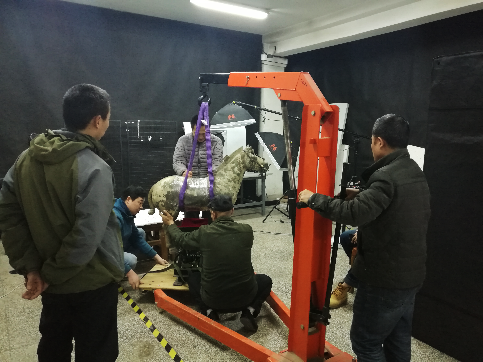Tianjin University (TJU) has succeed in employing digital technology to collect a gigantic amount of data from a historical relic in Xi'an, Northwest China's Shaanxi province, paving the way for up-coming archaeological studies and high-precision restoration and reproduction.

The research team from Tianjin University collects data of the No.2 Bronze Carriage from the Qin Shi Huang Mausoleum. [Photo/Tianjin University]
After seven rounds of field work over one year, the Information Technology Research Center for Cultural Heritage Protection and Inheritance of TJU has gathered 51 gigabyte of cloud data about the No.2 Bronze Carriage from the mausoleum of Qin Shi Huang, the First Emperor of Qin (259 BC-210 BC), with the help of 3D technologies.
The No. 2 Bronze Carriage, with more than 3000 components, is 317cm long and 106.2cm high and weighs 1,241 kilograms, including 14 kilograms of gold and silver ornaments.
It was shaped through various crafts like casting, inlaying, welding and snap-buckle and hinged-joint connecting.
It is the largest ancient carriage with the most complex structure and the most complete horse-harness relationship in China’s archaeological history yet discovered, and is widely regarded as the "Champion of Bronze".

The No.2 Bronze Carriage from the Qin Shi Huang Mausoleum [Photo/Tianjin University]
"In order to protect the cultural relics, we adhered to the principle of highest precision, minimum intervention, and non-contact methods," said Han Dong, associate professor from the School of Computer Software of TJU, who is in charge of the project.
"It might take quite a few days to collect the data of a bronze horse pertaining to its abdomen, buttocks, oral cavity and external martingales. To ensure the data integrity of the horse, we also collected the data of the bottom of the horseshoe." Han added.
Han's team used a three-dimensional laser scanner with the highest precision of 0.02 mm to acquire a total of 51 gigabytes of data.
To cope with the astronomical figure, the research team figured out a way to compress the face value of a single model without undermining model quality, and successfully completed all steps, including model registration, repair and optimization.
China Daily: http://www.chinadaily.com.cn/edu/2018-05/04/content_36141760.htm
Originally written by Bao Yanyan
Editors: Yin Wei & Doris Harrington






